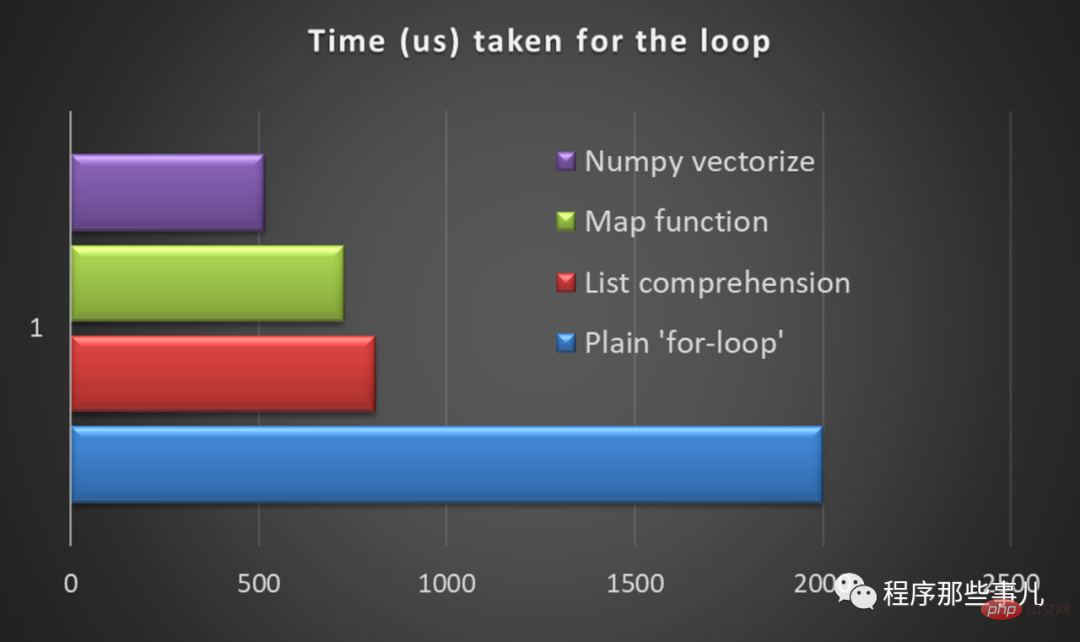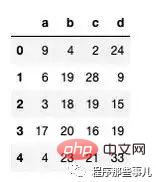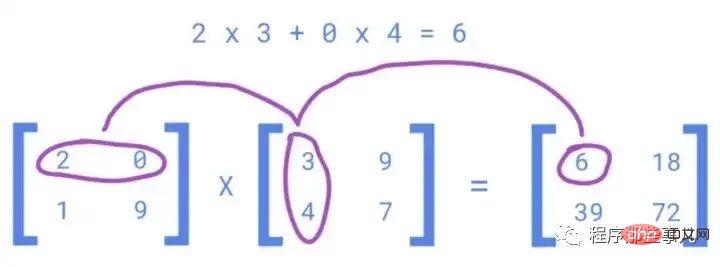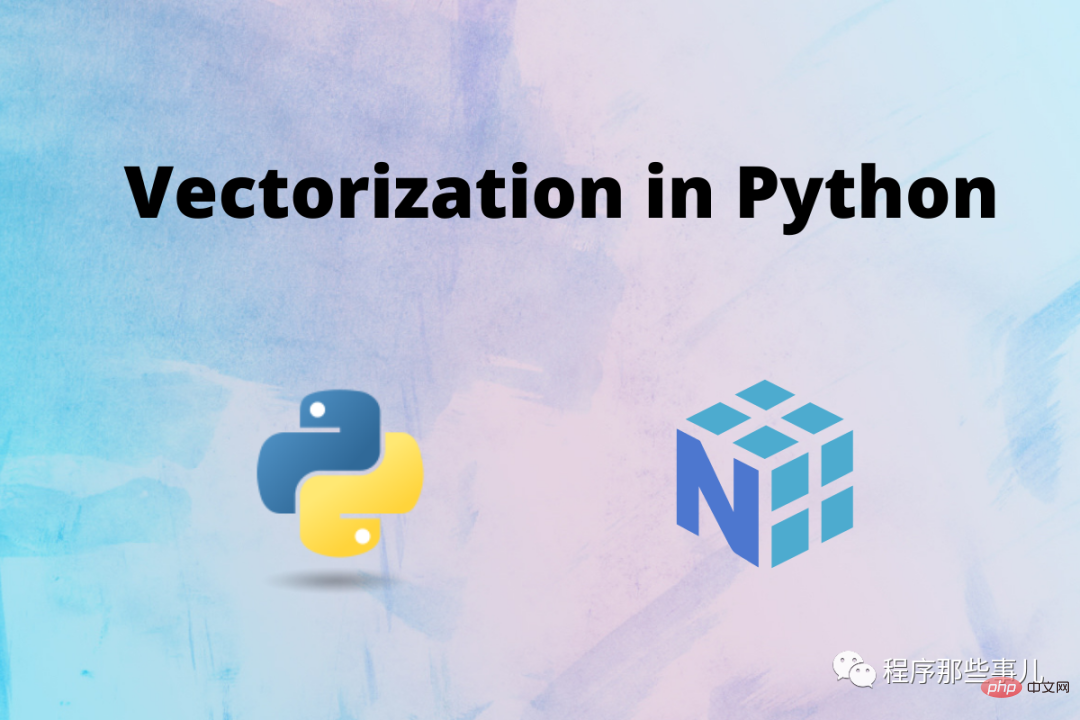Using vectorization to replace loops in python
All programming languages are inseparable from loops. So, by default, we start executing a loop whenever there is a repeating operation. But when we are dealing with large number of iterations (millions/billions of rows), using loops is a crime. You might be stuck for a few hours, only to realize later that it doesn't work. This is where implementing vectorization in python becomes very critical.

What is vectorization?
Vectorization is a technique for implementing (NumPy) array operations on data sets. Behind the scenes, it applies the operation to all elements of the array or series at once (unlike a "for" loop that operates one row at a time).
Next we use some use cases to demonstrate what vectorization is.
Find the sum of numbers
##使用循环
import time
start = time.time()
# iterative sum
total = 0
# iterating through 1.5 Million numbers
for item in range(0, 1500000):
total = total + item
print('sum is:' + str(total))
end = time.time()
print(end - start)
#1124999250000
#0.14 Seconds## 使用矢量化 import numpy as np start = time.time() # vectorized sum - using numpy for vectorization # np.arange create the sequence of numbers from 0 to 1499999 print(np.sum(np.arange(1500000))) end = time.time() print(end - start) ##1124999250000 ##0.008 Seconds
The execution time of vectorization is reduced by about 18 times compared to iteration using range functions. This difference becomes even more significant when using Pandas DataFrame.
Math Operations
In data science, when working with Pandas DataFrame, developers use loops to create new derived columns through mathematical operations.
In the example below we can see how easy it is to replace loops with vectorization for such use cases.
DataFrame is tabular data in the form of rows and columns.
We create a pandas DataFrame with 5 million rows and 4 columns filled with random values between 0 and 50.

import numpy as np import pandas as pd df = pd.DataFrame(np.random.randint( 0 , 50 , size=( 5000000 , 4 )), columns=( 'a' , 'b' , 'c' , 'd ' )) df.shape # (5000000, 5) df.head()
Create a new column "ratio" to find the ratio of columns "d" and "c".
## 循环遍历 import time start = time.time() # 使用 iterrows 遍历 DataFrame for idx, row in df.iterrows(): # 创建一个新列 df.at[idx, 'ratio' ] = 100 * (row[ "d" ] / row[ "c" ]) end = time.time() print (end - start) ### 109 秒
## 使用矢量化 start = time.time() df[ "ratio" ] = 100 * (df[ "d" ] / df[ "c" ]) end = time.time() print (end - start) ### 0.12 秒
We can see significant improvements with the DataFrame, with the vectorized operation taking almost 1000 times faster compared to the loop in Python.
If-else statement
We have implemented many operations that require us to use "If-else" type logic. We can easily replace this logic with vectorized operations in python.
Let's see the following example to understand it better (we will use the DataFrame we created in use case 2):
Imagine that we want to create a data based on the existing column "a" Create a new column "e" with some condition on
## 使用循环 import time start = time.time() # 使用 iterrows 遍历 DataFrame for idx, row in df.iterrows(): if row.a == 0 : df.at[idx, 'e' ] = row.d elif ( row.a <= 25 ) & (row.a > 0 ): df.at[idx, 'e' ] = (row.b)-(row.c) else : df.at[idx, 'e' ] = row.b + row.c end = time.time() print (end - start) ### 耗时:166 秒
## 矢量化 start = time.time() df[ 'e' ] = df[ 'b' ] + df[ 'c' ] df.loc[df[ 'a' ] <= 25 , 'e' ] = df [ 'b' ] -df[ 'c' ] df.loc[df[ 'a' ]== 0 , 'e' ] = df[ 'd' ]end = time.time() 打印(结束 - 开始) ## 0.29007707595825195 秒
The vectorized operation takes 600 times faster compared to a python loop using if-else statements.
Solving Machine Learning/Deep Learning Networks
Deep learning requires us to solve multiple complex equations, and there are millions and millions of equations to solve. The billion-row problem. Running loops to solve these equations in Python is very slow and vectorization is the best solution.
For example, calculate the y-values for millions of rows in the following multiple linear regression equation:
We can vectorize instead of looping.

The values of m1, m2, m3... are determined by solving the above equation using millions of values corresponding to x1, x2, x3...


import numpy as np # 设置 m 的初始值 m = np.random.rand( 1 , 5 ) # 500 万行的输入值 x = np.random.rand( 5000000 , 5 )
## 使用循环
import numpy as np
m = np.random.rand(1,5)
x = np.random.rand(5000000,5)
total = 0
tic = time.process_time()
for i in range(0,5000000):
total = 0
for j in range(0,5):
total = total + x[i][j]*m[0][j]
zer[i] = total
toc = time.process_time()
print ("Computation time = "+ str ((toc - tic)) + "seconds" )
####计算时间 = 27.02 秒## 矢量化 tic = time.process_time() #dot product np.dot(x,mT) toc = time.process_time() print ( "计算时间 = " + str ((toc - tic)) + "seconds" ) ####计算时间 = 0.107 秒
np.dot Implements vectorized matrix multiplication in the backend. It is 165 times faster compared to loops in Python.
Conclusion
Vectorization in python is very fast and should be preferred over loops whenever we are dealing with very large data sets.

# As you start implementing it over time, you will get used to thinking in terms of vectorization of your code.
The above is the detailed content of Using vectorization to replace loops in python. For more information, please follow other related articles on the PHP Chinese website!

Hot AI Tools

Undresser.AI Undress
AI-powered app for creating realistic nude photos

AI Clothes Remover
Online AI tool for removing clothes from photos.

Undress AI Tool
Undress images for free

Clothoff.io
AI clothes remover

AI Hentai Generator
Generate AI Hentai for free.

Hot Article

Hot Tools

Notepad++7.3.1
Easy-to-use and free code editor

SublimeText3 Chinese version
Chinese version, very easy to use

Zend Studio 13.0.1
Powerful PHP integrated development environment

Dreamweaver CS6
Visual web development tools

SublimeText3 Mac version
God-level code editing software (SublimeText3)

Hot Topics
 1378
1378
 52
52
 Master PyCharm replacement shortcut keys in 5 minutes and easily increase your programming speed!
Feb 22, 2024 am 10:57 AM
Master PyCharm replacement shortcut keys in 5 minutes and easily increase your programming speed!
Feb 22, 2024 am 10:57 AM
PyCharm is a commonly used Python integrated development environment with rich functions and shortcut keys that can help developers improve programming efficiency. In the daily programming process, mastering PyCharm's shortcut key replacement skills can help developers complete tasks more quickly. This article will introduce you to some commonly used replacement shortcut keys in PyCharm to help you easily improve your programming speed. 1.Ctrl+R replacement In PyCharm, you can use the Ctrl+R shortcut key to perform replacement operations.
 Replace the class name of an element using jQuery
Feb 24, 2024 pm 11:03 PM
Replace the class name of an element using jQuery
Feb 24, 2024 pm 11:03 PM
jQuery is a classic JavaScript library that is widely used in web development. It simplifies operations such as handling events, manipulating DOM elements, and performing animations on web pages. When using jQuery, you often encounter situations where you need to replace the class name of an element. This article will introduce some practical methods and specific code examples. 1. Use the removeClass() and addClass() methods jQuery provides the removeClass() method for deletion
 PyCharm Beginner's Guide: Comprehensive Analysis of Replacement Functions
Feb 25, 2024 am 11:15 AM
PyCharm Beginner's Guide: Comprehensive Analysis of Replacement Functions
Feb 25, 2024 am 11:15 AM
PyCharm is a powerful Python integrated development environment with rich functions and tools that can greatly improve development efficiency. Among them, the replacement function is one of the functions frequently used in the development process, which can help developers quickly modify the code and improve the code quality. This article will introduce PyCharm's replacement function in detail, combined with specific code examples, to help novices better master and use this function. Introduction to the replacement function PyCharm's replacement function can help developers quickly replace specified text in the code
 PyCharm replaces shortcut keys to make programming more convenient!
Feb 21, 2024 pm 12:03 PM
PyCharm replaces shortcut keys to make programming more convenient!
Feb 21, 2024 pm 12:03 PM
PyCharm is an integrated development environment popular among programmers. It provides powerful functions and tools to make programming more efficient and convenient. In PyCharm, reasonable setting and replacement of shortcut keys is one of the keys to improving programming efficiency. This article will introduce how to replace shortcut keys in PyCharm to make programming more convenient. 1. Why should we replace shortcut keys? In PyCharm, shortcut keys can help programmers quickly complete various operations and improve programming efficiency. However, everyone has different habits, and some people may
 Lambda expression breaks out of loop
Feb 20, 2024 am 08:47 AM
Lambda expression breaks out of loop
Feb 20, 2024 am 08:47 AM
Lambda expression breaks out of the loop, specific code examples are needed. In programming, the loop structure is an important syntax that is often used. However, in certain circumstances, we may want to break out of the entire loop when a certain condition is met within the loop body, rather than just terminating the current loop iteration. At this time, the characteristics of lambda expressions can help us achieve the goal of jumping out of the loop. Lambda expression is a way to declare an anonymous function, which can define simple function logic internally. It is different from an ordinary function declaration,
 How to replace a word in Excel using Python?
Sep 16, 2023 pm 10:21 PM
How to replace a word in Excel using Python?
Sep 16, 2023 pm 10:21 PM
In Python, we can replace one word with another word in Excel using a third-party Python library called openpyxl. Microsoft Excel is a useful tool for managing and analyzing data. Using Python, we can automate some Excel data management tasks. In this article, we will learn how to replace a word in Excel using Python. Before installing openpyxl to replace Word in Excel, we need to install the openpyxl library in the system using the Python package manager. To install openpyxl, enter the following command in the terminal or command prompt. Pipinst
 Revealing the secret of how to quickly replace code in PyCharm
Feb 25, 2024 pm 11:21 PM
Revealing the secret of how to quickly replace code in PyCharm
Feb 25, 2024 pm 11:21 PM
PyCharm is a Python integrated development environment that is widely loved by developers. It provides many methods to quickly replace code, making the development process more efficient. This article will reveal several commonly used methods to quickly replace code in PyCharm, and provide specific code examples to help developers make better use of these features. 1. Use the replacement function PyCharm provides a powerful replacement function that can help developers quickly replace text in the code. Use the shortcut Ctrl+R or right-click in the editor and select Re
 PHP returns all the values in the array to form an array
Mar 21, 2024 am 09:06 AM
PHP returns all the values in the array to form an array
Mar 21, 2024 am 09:06 AM
This article will explain in detail how PHP returns all the values of an array to form an array. The editor thinks it is quite practical, so I share it with you as a reference. I hope you can gain something after reading this article. Using the array_values() function The array_values() function returns an array of all the values in an array. It does not preserve the keys of the original array. $array=["foo"=>"bar","baz"=>"qux"];$values=array_values($array);//$values will be ["bar","qux"]Using a loop can Use a loop to manually get all the values of the array and add them to a new




